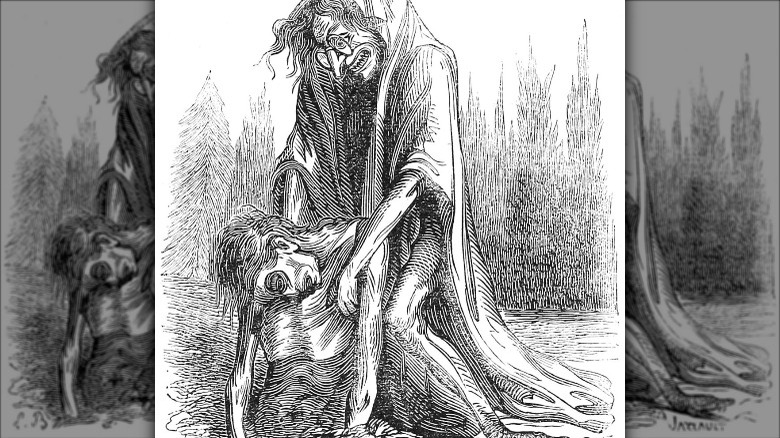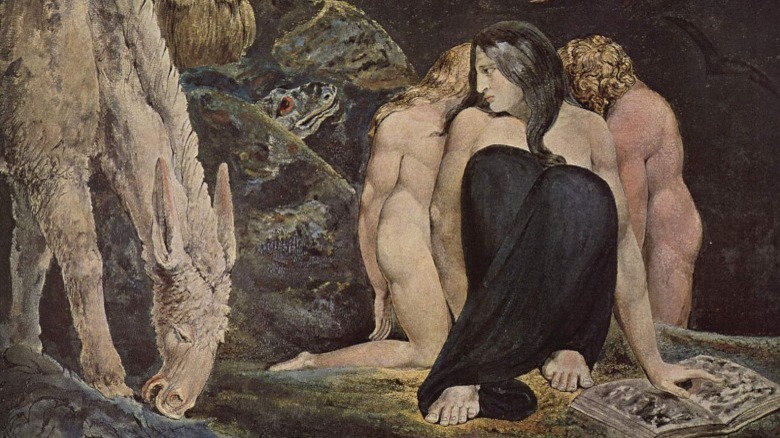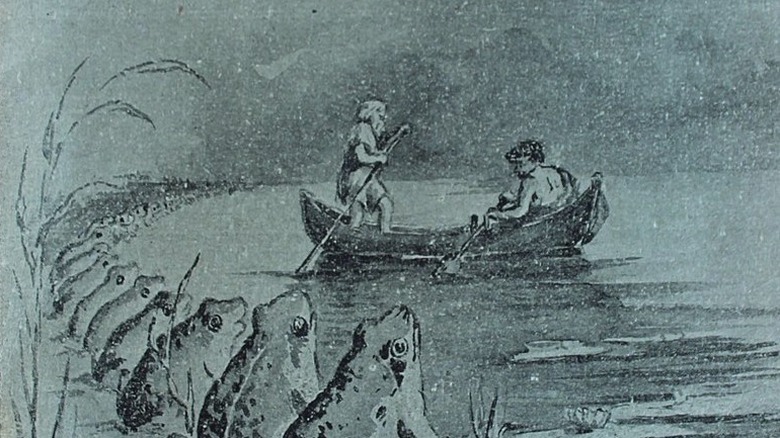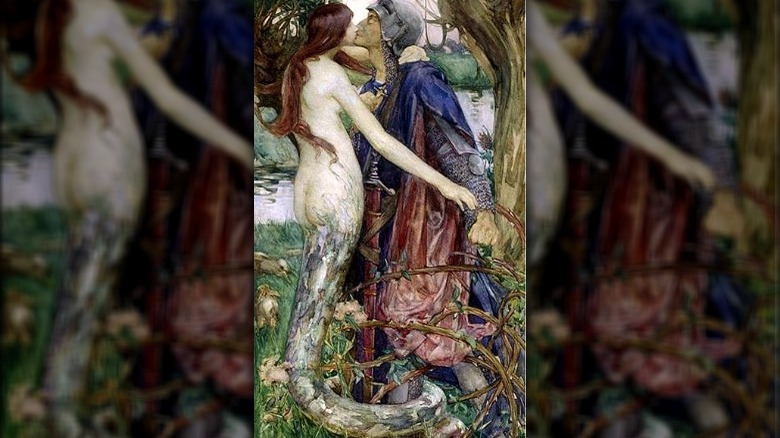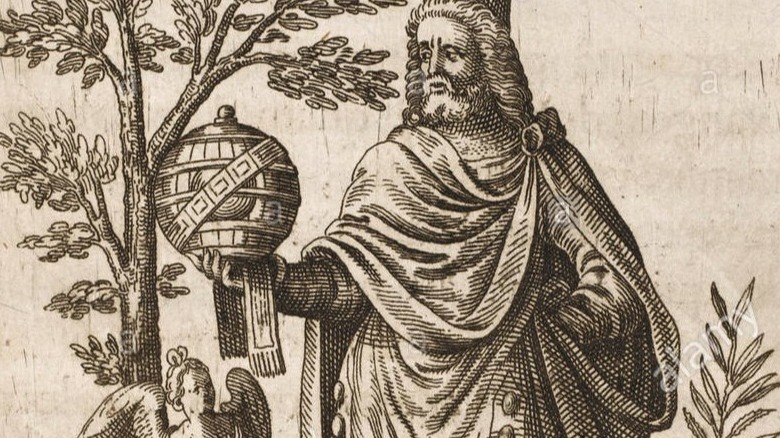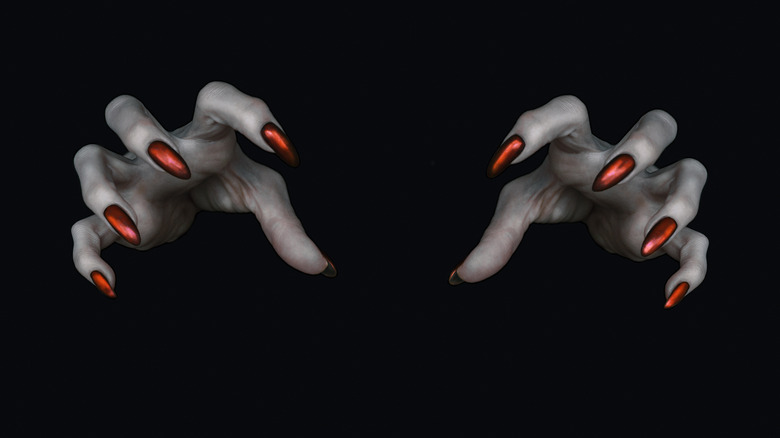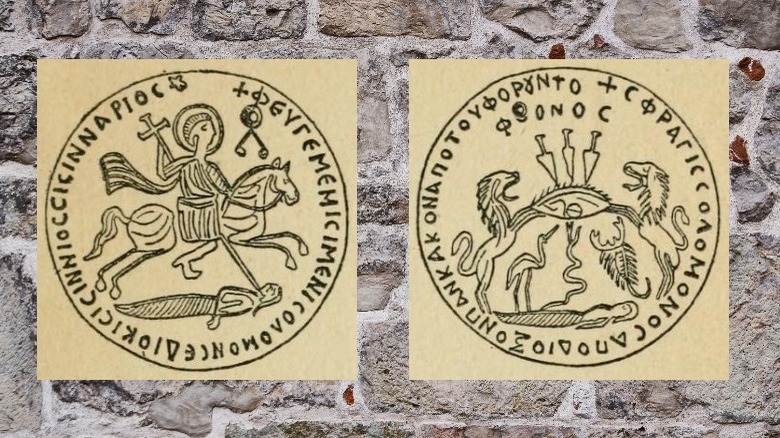The Myth Of The Empusa Explained
While 21st century humankind might think they're all kinds of cool, it's worth remembering that our ancient ancestors weren't too shabby themselves. Take the ancient Greeks. They had the know-how (and muscle power) to build stadiums, temples, and theaters that are still standing after thousands of years, they created some of the most mind-blowing sculptures and works of art in the world, and they had the technical ability to develop things like extensive aqueduct systems and the Olympics. They had a lot of scientific knowledge under their figurative belts, too. World History says they could calculate the schedules of a solar eclipse and diagnose tons of medical conditions, but there was still a lot of the world that was pretty mysterious.
And that's where mythology comes in. Ancient mythology was filled with stories like the tale of Demeter and Persephone. It wasn't just a great story, it also explained why the seasons happened. That's a beautiful tale of a mother's love for her daughter, but not all ancient myths have something so noble at their heart.
The world is full of terrible, awful, and sometimes bloodthirsty things, and that includes the Empusa. Demonic, hungry, monstrous... those are all accurate descriptions of the nightmarish creatures said to stalk the night after coming up from the depths of the underworld. Who were they? It's not pleasant, and just goes to show that anyone who's afraid of the dark? You're not alone.
Who were the Empusa?
Empusa, says Theoi, was just one of the names for the demonic women who stalked the night, looking for victims. They were called the Empousai, the Empusae, and they were also associated with a sort of sub-group called the Lamiai (or Lamiae). It's possible to go even one step further — they were also connected to creatures called the Mormolykeiai (or Mormo), and who were they all?
Imagine some of the most terrible monsters in the world. What are the first things that come to mind? If it's vampire, demons, and succubi, then congratulations, because those can all get smashed together in one terrifying entity, and that's the Empusa. The Empusa, the Lamiai, and the Mormolykeiai have pretty much the same thing going on, but there are some important differences. The Empusa had a pretty distinct appearance: Instead of hair, they had fire wreathing their heads. They also had one brass leg, and the other was that of a donkey. Terrifying? Definitely: These creatures were dispatched from the depths of hell to literally prey on unwary travelers.
Lamiai, too, were ghastly specters unleashed on the unwitting of the world. The stories of these women developed a little later in history and grew out of the tales of the Empusa, and it was these creatures that laid the groundwork for our modern vampires. Then, there's the Mormolykeiai. This version targeted children, and was said to be a female demon who would — like a demonic bogeyman — prey on the young.
They were the daughters of Hecate, goddess of witchcraft
Tracing the genealogy of the Greek gods isn't so much looking at a family tree as it is a family briar patch, but the origins of the Empusa are pretty straightforward. Well, as straightforward as mythology gets.
The Byzantine Greek Lexicon — which dates to some time in the 10th century — says (via Theoi) that the Empusa was the companion of the goddess Hekate, travelling in her entourage. Other sources say that she was an incarnation of the goddess herself, while others still say that she was the daughter of Hekate.
Hekate was a bit of a rarity in the pantheon. While many of the gods had power over one area or realm — Poseidon and the sea, for example — Hekate had dominion over everything from the heavens to the deepest, darkest depths. She was the daughter of two Titans (or sometimes, of Zeus and one of his many, many conquests), and the goddess of things like witchcraft and magic, necromancy, the night, and the spectral forms that crossed between the living and the dead. She's sometimes a virgin goddess associated with Artemis and Demeter, but given her dominion over the otherworldly, it's easy to see how she became associated with the demonic, spectral, ever-hungry Empusa.
The super-disturbing tale of Solomon's Empusa
Some super interesting things were going on in the first century, including the spread of Christianity and Judaism. According to Murdoch University's William Loader (via MDPI), these new religions took the moral high ground over what they viewed as the sexually and morally loose believers in the old Greco-Roman traditions. And here's where the Empusa comes in.
In The Testament of Solomon (via the Oxford Biblical Studies), Solomon asks the devil to show him a female demon, and he summons one from the depths. She was breathtakingly beautiful, but her true nature was evident in her legs: They were the legs of a donkey. When asked who she was, she responded: "I am called Onoskelis ... who lurks in holes on earth ... my ways are varied. Sometimes I choke a man: sometimes I pervert them from their nature."
Onoskelis' origin story is told in Pseudo-Plutarch (via Theoi), and it's dark stuff. She's the daughter of a man named Aristonymos of Ephesos, who hated women so completely that he refused to have anything to do with them, and instead, used a donkey to fulfill his carnal urges. Onoskelis was the result of that disturbing union, and would later be used to show just hot barbaric and depraved believers in the old ways were. There was thought to be some hope for her, though... sort of. She was blessed by Solomon and ordered to spin hemp for God. She's been doing it ever since.
How about that time Dionysus faced one?
An Empusa, one shows up in Aristophanes' play "The Frogs" ... maybe. The short version of the story is that it's the tale of Dionysus and his slave Xanthias, who are heading into the Underworld on a mission to rescue Euripides. After asking Heracles for some advice, they head down to Hades.
After crossing Charon's lake, it's only Xanthias who sees the horrible figure of the Empusa (via PhilPapers). He describes it as "the most ferocious monster," and narrates her shape-changing to the god. She changes from a bull to a mule and into a beautiful woman, then into a dog, and then, Xanthias says, "Well, its face is all ablaze with fire." He adds that yes, there's one copper leg and "one of cow dung," and Dionysus pleads with his servant to protect him. Xanthias tells it to go away, and it does. A petrified Dionysus makes Xanthias swear three times on Zeus' name that it's actually gone, and here's the question: Was it there in the first place?
An interpretation of the work by professors at the GC Women University Sialkot suggests that it was just one more of Xanthias' tricks — which he plays throughout the comedy, all at the expense of Dionysus. It had the dual purpose of reinforcing the fact that all of Heracles' warnings about the Underworld needed to be taken very seriously, and as for making Dionysus look like a coward? That was kind of a bonus.
The story of how to scare off an Empusa
Now, here's some good news: For anyone who was brave enough to keep their wits about them when faced with the ghastly visage of the Empusa, it was easy enough to scare them away.
The tactics were shared by the 1st century AD teacher and philosopher Apollonius of Tyana. His life and wisdom were the subject of a work by the ancient writer Philostratus, and Livius says that all included how to vanquish the Empusa. Apollonius was reportedly traveling through the Caucasus with a group of companions when an Empusa ambushed them on the road. He knew what the ghostly figure was immediately, as her form flickered and changed, occasionally disappearing completely. That's when Apollonius started to insult her. Really.
Instructing everyone else to do the same, they hurled abuse and insults at the creature until it fled into the night, screams trailing in its wake. So, while the Empusa might be a monstrous nightmare of a ghoul, it's easy enough to get rid of — if you're brave about it, and have some insults at the ready.
Let's talk about the Lamiai
Greek mythology can get a little confusing. According to Theoi, the Empusa were one of a group of female demons who fed on humans. While the Empusa had mismatched legs, the closely related Lamiai had "legs" that were a snake's tail. To make things more complicated, there were a few different versions of the Lamiai, so let's talk about the one that's going to sound familiar to anyone who's a fan of modern day horror movies.
These Lamiai were illusionists who could use their magic to hide their true forms. They would shapeshift into beautiful women, and select their target, which was usually a young man. After seducing him, they would drink their blood and feed on their flesh, because everyone knows that it's the flesh and blood of the young that is the most delicious — it's Vampire 101. This all sounds familiar for a good reason: The Lamiai were early vampires, particularly one named Philinnion.
Philinnion's story is a heartbreaking one, and according to Theoi, it's often said to be the first vampire story. It starts with her untimely death, and her subsequent return as an undead corpse. Finding a young man staying with her parents' home, she hooks up with him. It was a love that wasn't meant to be, though, and when her mother confronts her, she dies again. The townspeople clearly don't want her to rise again to finish the job and drink the man's blood, so they burn her very lively remains.
The tale of the Korinthian Empusa
One of the most detailed stories of the Empusa is the tale of the Lamiai Korinthia, retold by Philostratus (via Theoi). It started with Menippos, the handsome young philosopher and student of Apollonius of Tyana (pictured). He was walking alone one night when the specter of a woman appeared to him, telling him that she had been admiring him from afar long enough to fall in love with him, and if he was interested, he really should go to find her. He followed her directions, went to her home, and found himself falling in love with her, too.
He started visiting her regularly, and when his teacher asked him if he planned on marrying the mysterious woman, he said, "Sure, how about tomorrow?" The whole thing was going to go through, but on the day of the wedding, Apollonius confronted her: "You may realize the truth of what I say, this fine bride is one of the Lamiai."
She tried to deny it, but even as Apollonius continued to talk, everything around them — from the food and wine to the servants — disappeared. Now cowering before the onslaught of truthful accusations, she admitted that yes, she was one of the Empusa, and her interest in Menippos had been purely culinary. Apollonius was able to save his student, but it's also implied that there were others that he couldn't save.
Then, there's also Queen Lamia
Theoi says that in addition to the generic, vampiric Lamiai, there was also a woman named Lamia — and her story is a little different. As the daughter of Poseidon, Lamia was both a demigod and a queen of Libya. Unfortunately, she was also one of the many women who caught the lusting eye of her uncle Zeus, who pursued her and ultimately had at least one child with her, the future shark-sea-demon, Akheilos. She was also the mother of at least three others (including Skylla, the sea-demon who staked out a claim near the whirlpool Kharybdis), and here's where things get dark.
Stories vary, but it's generally agreed that when Hera found out that she'd hooked up with Zeus, the queen goddess got her revenge by kidnapping Lamia's children. The act sent her into a spiral of madness: Seized by grief, she gouged out her own eyes.
It's then that Zeus intervened, with the kind of solution that only a Greek god could come up with. He not only gave her eyes back, but for whatever reason, gave her the power to remove and reinsert them at will. He also gave her a monstrous appearance — she's described as shark-like — and the power to get revenge for the loss of her own children. She became known as a she-demon who wandered the earth, stealing the children of others and killing them — sharing the pain that Hera had given her.
Their evolution into the child-stealing witch
The Empusa may have originated in ancient Greece, but oddly, it's incredibly easy to trace her evolution right up into one of the most popular series on Netflix. According to research from the University of Silesia, Katowice, the term "gello" was one of a number of nearly-forgotten Greek words preserved in a 5th-century dictionary written by a scholar called Hesychius of Alexandria. It was defined as a demon that not only kidnapped children, but was something of a child itself: It was a baby Empusa. The word "Gello" also shows up in Byzantine stories, where it was the proper name of a particular demon. She did the usual child stealing and eating, but she was also said to kill by tearing out their livers, and when John of Damascus started writing about these terrible creatures, he called them striges.
From there, striges (or strix, or striga) evolved into shape-shifting demons that killed sleeping children (via Cambridge University Press). The Encyclopedia of Vampire Mythology gets a little more detailed, saying that the striga was believed to be the demonic resurrection of a woman who had been a witch in life, and in death, was condemned to feed on the flesh and blood of children. Some would die immediately, while others would waste away.
Not only is this a version of modern vampires, but it's also one of the monsters that Geralt comes face-to-face with in "The Witcher" — which brings us to the promised Netflix series.
The overlap into Christianity happened with Gyllou
Mythology and religion are often a brilliant tapestry of stories, with all kinds of threads that weave around each other. The Empusa is certainly no different, and stories of this ancient Greek demon end up winding their way into early Christian tales. Empusas, says Katarzyna Wojcik-Owczarek of the University of Silesia, Katowice, were adopted into Byzantine lore as the child-destroying demon called Gello. Gello — or Gyllou, and also Gellou — was said to have stolen the seven children of a woman named Melitene. Not wanting the demon to steal her eighth child, she sealed herself in a fortress. When her brothers came to visit, though, she allowed them in — and in doing so, she allowed Gello in as well. The demon had shapeshifted into dust, and ultimately killed the newborn baby.
Melitene's brothers were the saints Sisinnios and Sisinnodoros, and God answered their prayers. Giving them a divine blessing, they headed out in search of the demon. They eventually caught her and convinced her to give back the seven original children. They also convinced her to promise not to harm any children from families who paid her homage, and kept a charm inscribed with her names.
The charms still exist: According to the Harvard Art Museum, they're called Holy Rider Amulets, and they date back to between the 5th and 7th centuries. In addition to an image of St. Sisinnios impaling the demon on a spear, they typically also feature the demon's 12 names, and bridge the gap between ancient mythology and early Christian saints' tales.

